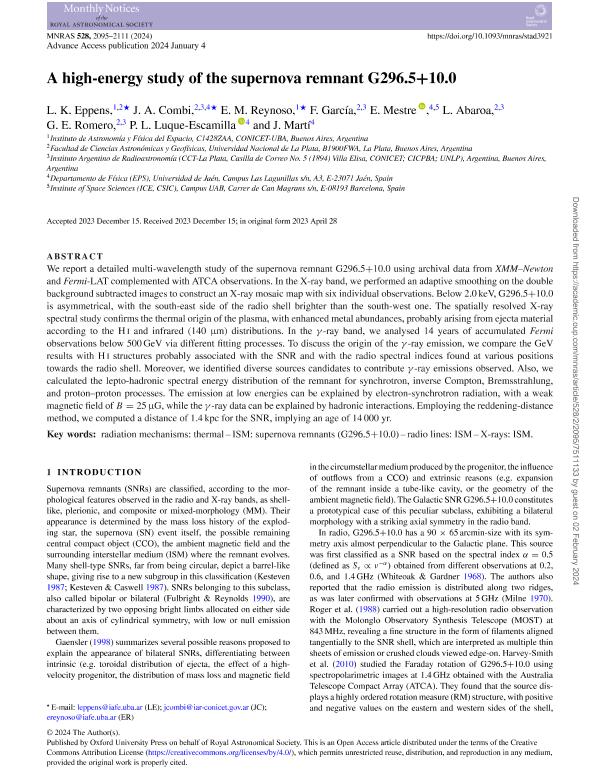Mostrar el registro sencillo del ítem
dc.contributor.author
Eppens, Laura Karina

dc.contributor.author
Combi, Jorge Ariel

dc.contributor.author
Reynoso, Estela Marta

dc.contributor.author
García, Federico

dc.contributor.author
Mestre, E.
dc.contributor.author
Abaroa, Leandro

dc.contributor.author
Romero, Gustavo Esteban

dc.contributor.author
Luque Escamilla, Pedro L.

dc.contributor.author
Martí, J.
dc.date.available
2024-03-19T11:21:35Z
dc.date.issued
2024-02
dc.identifier.citation
Eppens, Laura Karina; Combi, Jorge Ariel; Reynoso, Estela Marta; García, Federico; Mestre, E.; et al.; A high-energy study of the supernova remnant G296.5+10.0; Oxford University Press; Monthly Notices of the Royal Astronomical Society; 528; 2; 2-2024; 2095-2111
dc.identifier.issn
0035-8711
dc.identifier.uri
http://hdl.handle.net/11336/230859
dc.description.abstract
We report a detailed multi-wavelength study of the supernova remnant G296.5+10.0 using archival data from XMM–Newton and Fermi-LAT complemented with ATCA observations. In the X-ray band, we performed an adaptive smoothing on the double background subtracted images to construct an X-ray mosaic map with six individual observations. Below 2.0 keV, G296.5+10.0 is asymmetrical, with the south-east side of the radio shell brighter than the south-west one. The spatially resolved X-ray spectral study confirms the thermal origin of the plasma, with enhanced metal abundances, probably arising from ejecta material according to the H I and infrared (140 μm) distributions. In the γ -ray band, we analysed 14 years of accumulated Fermi observations below 500 GeV via different fitting processes. To discuss the origin of the γ -ray emission, we compare the GeV results with H I structures probably associated with the SNR and with the radio spectral indices found at various positions towards the radio shell. Moreover, we identified diverse sources candidates to contribute γ -ray emissions observed. Also, we calculated the lepto-hadronic spectral energy distribution of the remnant for synchrotron, inverse Compton, Bremsstrahlung, and proton–proton processes. The emission at low energies can be explained by electron-synchrotron radiation, with a weak magnetic field of B = 25 μG, while the γ -ray data can be explained by hadronic interactions. Employing the reddening-distance method, we computed a distance of 1.4 kpc for the SNR, implying an age of 14 000 yr.
dc.format
application/pdf
dc.language.iso
eng
dc.publisher
Oxford University Press

dc.rights
info:eu-repo/semantics/openAccess
dc.rights.uri
https://creativecommons.org/licenses/by-nc-sa/2.5/ar/
dc.subject
ISM: SUPERNOVA REMNANTS (G296.5+10.0)
dc.subject
RADIATION MECHANISMS: THERMAL
dc.subject
RADIO LINES: ISM
dc.subject
X-RAYS: ISM
dc.subject.classification
Astronomía

dc.subject.classification
Ciencias Físicas

dc.subject.classification
CIENCIAS NATURALES Y EXACTAS

dc.title
A high-energy study of the supernova remnant G296.5+10.0
dc.type
info:eu-repo/semantics/article
dc.type
info:ar-repo/semantics/artículo
dc.type
info:eu-repo/semantics/publishedVersion
dc.date.updated
2024-03-15T14:41:05Z
dc.identifier.eissn
1365-2966
dc.journal.volume
528
dc.journal.number
2
dc.journal.pagination
2095-2111
dc.journal.pais
Reino Unido

dc.journal.ciudad
Londres
dc.description.fil
Fil: Eppens, Laura Karina. Consejo Nacional de Investigaciónes Científicas y Técnicas. Oficina de Coordinación Administrativa Ciudad Universitaria. Instituto de Astronomía y Física del Espacio. - Universidad de Buenos Aires. Facultad de Ciencias Exactas y Naturales. Instituto de Astronomía y Física del Espacio; Argentina
dc.description.fil
Fil: Combi, Jorge Ariel. Universidad Nacional de La Plata. Facultad de Ciencias Astronómicas y Geofísicas; Argentina. Provincia de Buenos Aires. Gobernación. Comisión de Investigaciones Científicas. Instituto Argentino de Radioastronomía. Consejo Nacional de Investigaciones Científicas y Técnicas. Centro Científico Tecnológico Conicet - La Plata. Instituto Argentino de Radioastronomía; Argentina. Universidad de Jaén; España
dc.description.fil
Fil: Reynoso, Estela Marta. Consejo Nacional de Investigaciónes Científicas y Técnicas. Oficina de Coordinación Administrativa Ciudad Universitaria. Instituto de Astronomía y Física del Espacio. - Universidad de Buenos Aires. Facultad de Ciencias Exactas y Naturales. Instituto de Astronomía y Física del Espacio; Argentina
dc.description.fil
Fil: García, Federico. Provincia de Buenos Aires. Gobernación. Comisión de Investigaciones Científicas. Instituto Argentino de Radioastronomía. Consejo Nacional de Investigaciones Científicas y Técnicas. Centro Científico Tecnológico Conicet - La Plata. Instituto Argentino de Radioastronomía; Argentina
dc.description.fil
Fil: Mestre, E.. Universidad de Jaén; España
dc.description.fil
Fil: Abaroa, Leandro. Consejo Nacional de Investigaciones Científicas y Técnicas. Oficina de Coordinación Administrativa Ciudad Universitaria. Instituto de Astronomía y Física del Espacio. - Universidad de Buenos Aires. Facultad de Ciencias Exactas y Naturales. Instituto de Astronomía y Física del Espacio; Argentina
dc.description.fil
Fil: Romero, Gustavo Esteban. Consejo Nacional de Investigaciones Científicas y Técnicas. Oficina de Coordinación Administrativa Ciudad Universitaria. Instituto de Astronomía y Física del Espacio. - Universidad de Buenos Aires. Facultad de Ciencias Exactas y Naturales. Instituto de Astronomía y Física del Espacio; Argentina
dc.description.fil
Fil: Luque Escamilla, Pedro L.. Universidad de Jaén; España
dc.description.fil
Fil: Martí, J.. Universidad de Jaén; España
dc.journal.title
Monthly Notices of the Royal Astronomical Society

dc.relation.alternativeid
info:eu-repo/semantics/altIdentifier/url/https://academic.oup.com/mnras/article/528/2/2095/7511133
dc.relation.alternativeid
info:eu-repo/semantics/altIdentifier/doi/http://dx.doi.org/10.1093/mnras/stad3921
Archivos asociados
